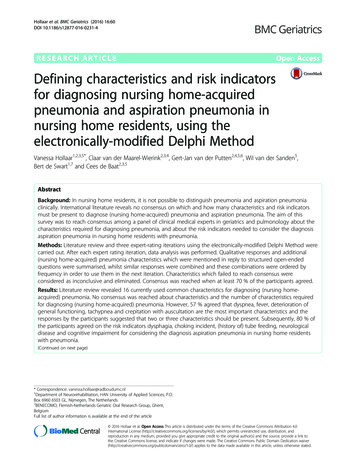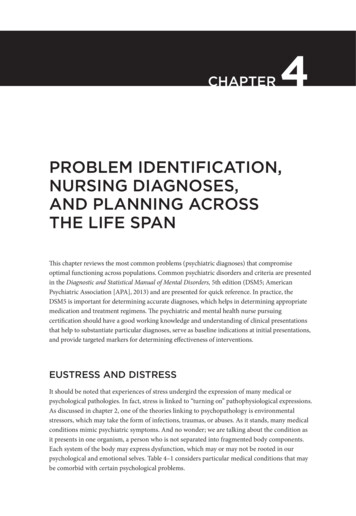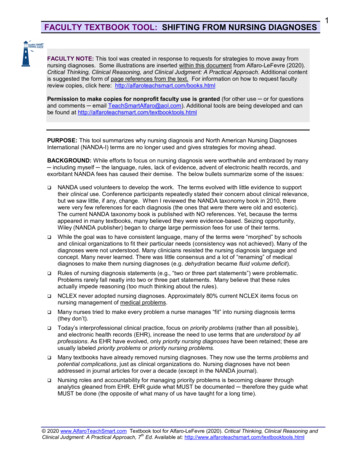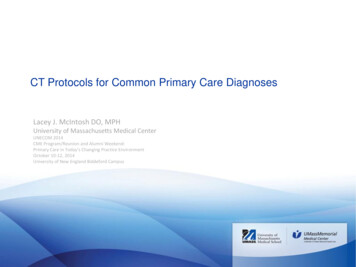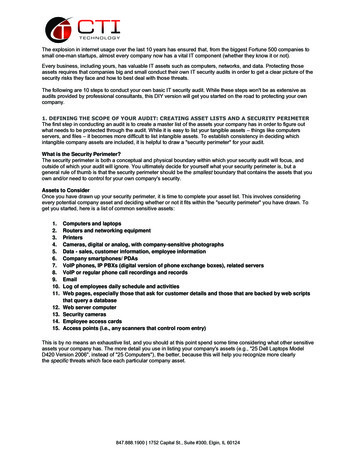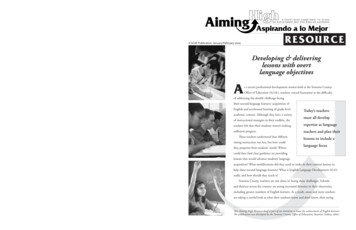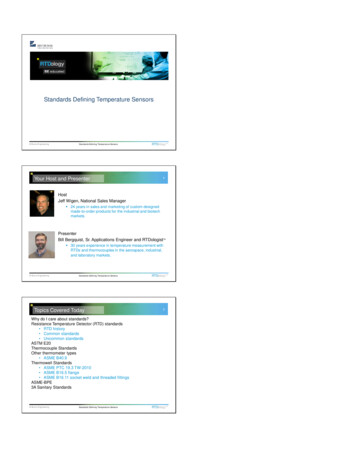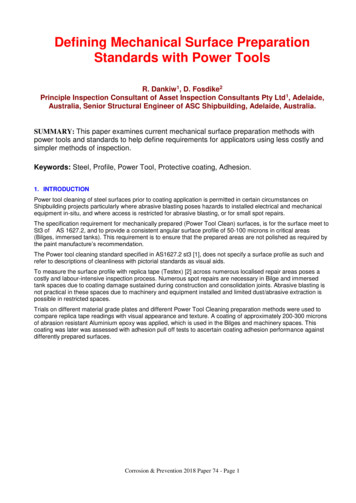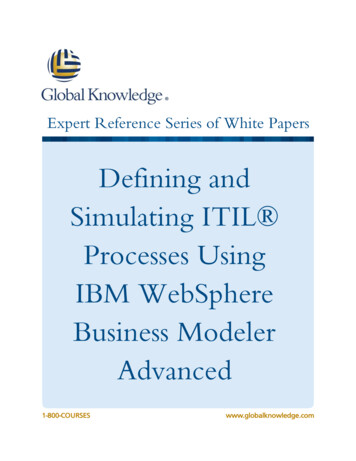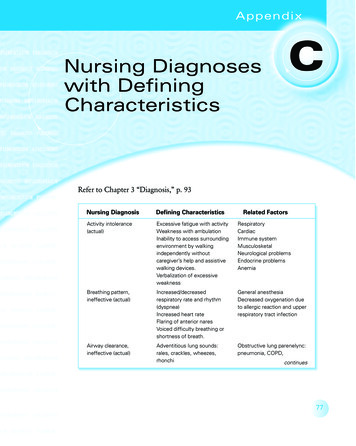
Transcription
AppendixCNursing Diagnoseswith DefiningCharacteristicsRefer to Chapter 3 “Diagnosis,” p. 93Nursing DiagnosisDefining CharacteristicsRelated FactorsActivity intolerance(actual)Excessive fatigue with activityWeakness with ambulationInability to access surroundingenvironment by walkingindependently withoutcaregiver’s help and assistivewalking devices.Verbalization of excessiveweaknessRespiratoryCardiacImmune systemMusculosketalNeurological problemsEndocrine problemsAnemiaBreathing pattern,ineffective (actual)Increased/decreasedrespiratory rate and rhythm(dyspnea)Increased heart rateFlaring of anterior naresVoiced difficulty breathing orshortness of breath.General anesthesiaDecreased oxygenation dueto allergic reaction and upperrespiratory tract infectionAirway clearance,ineffective (actual)Adventitious lung sounds:rales, crackles, wheezes,rhonchiObstructive lung parenelync:pneumonia, COPD,continues77
78Appendix CNursing DiagnosisDefining CharacteristicsRelated FactorsIneffective coughCyanosesDyspneaOrthopneaTenacious mucuscancer, tuberculosis,emphysema, trauma(pneumothorax)Anxiety, high (actual)InattentionFailure to concentrateIllogical thought process/reasoningForgetfulnessAnorexiaPersistant eating—bingeeatingRestlessnessFidgetingRapid eye movementsMemory lossFailure to learnInability to concentrateCrying spellsFrequency of urinationPrecipitancy of urinationInability to recall pastincidentsProlonged illnessEconomic disasterUnfamiliar environment suchas hospitalizationRole changeDisaster—physical such asenvironmental and/or familiarUnresolved stressInherited psychologicalstatesSpiritual emptinessChange of statusChange of localityPostpartum stressorsKnowledge deficit related tospecific problem-solving skillsConflict related to values andethical issuesDrug related: prescribed andillegal.Body image disturbed(actual)Denial of change in bodystructureOvercompensation for loss orchange in body structureRegression to earlier stage ofdevelopmentDependence of peers,significant others, or caregiverVerbal discussion ofperception of self.Nonverbal behaviordemonstrating rejectionof selfSoliciting support from othersfor incompetencePoor self-imagingInactivitySomnolenceObesity/morbid obesityLoss of body partUnacceptance among peersNegative reinforcement fromsignificant othersUnrealistic expectationfrom selfUnrealistic expectationfrom othersRepeated failureGluttonyAnorexia nervosaChronic illnessLack of supportDepressionLack of motivationOvermedication (prescription, over the counter, and/orillegal)continues
Appendix CNursing DiagnosisDefining CharacteristicsBody temperatureimbalance; hyperthermia(actual)Beginning stage Rapid heartbeat Increased respirationsAshen or cyanoticappearance of the skin Skin cool or cold to touch Shivering spell Generalized spread ofgoosebumps over body Complaints of generalizedcoldness over body Temperature generallynormal Skin dry to touchRelated FactorsAge—Temperature changesmore labile in elderly adultsand young childrenStrenuous exerciseHormonal changes particularly in womenEnvironmental conditions—vary (hot weather)Infectious agentsAppearance and stage offever Shivering abates Elevated temperature Complaints of thirst Signs of dehydration—drymuscus membranes,decreased urinary output Complaints of sensitivity tolight Anorexia Generalized weakness Muscle aches Restlessness, sleeplessness,confusion/disorientation Rapid heart rate andincreased respirations Herpes simplexBody temperatureimbalance; hypothermiaTemperature below normal Pulse and respirationsdecrease Skin pale, cold and clammy Decreased blood pressure Diminished urination Shivering spell Drowsiness and confusionExposure to cold environment Improper clothing andshelter Abuse of sedatives Inadequate thermoregulationof the hypothalamicthermostatBowel incontinence(actual)Inability to control the passageof stoolPassing of small amounts ofstool constantlyLack of sphincter controlInability to access bathroomImmobilitycontinues79
80Appendix CNursing DiagnosisDefining CharacteristicsRelated FactorsPresence of stool on clothingStool liquid in natureMinimal urge or no feeling orurge to defecateIrritation of perineurial areaUrgencyLower motor neurondamageIntestinal obstructionDiet relatedIntestinal abnormalitiesLoss of muscle toneDiseases, colon and/or rectalCommunication, impairedverbal (actual)AphasiaRefusal to speakMuttering/stutteringLack of comprehension of thephases of communication(sender- message-receiver)Poor formulation of words andsentencesInability to speak the expectedlanguageDyspneaTachypneaAltered self-conceptKnowledge deficitSelf-imposed behaviorDiminished blood flow to thebrain (due to tumors orcerebrovascular accidentsand/or coma)Congenital anomalyDevelopmental stageImposed surgical interventions such as tracheostomyCultural barriersEnvironmental changeLow I.Q.Unclear messages(uninformed)Infection (actual)Findings at the site of theinfection: Redness Swelling Pain HeatImpaired functioning of theaffected limb or part (wheninfection is severe)Elevated temperature withelevated pulse and respirationsGeneralized weakness andmalaise (cachectic): Loss of appetite Complaints of thirst Nausea and vomiting Palpable lymph nodesLaboratory profile: IncreasedWBC Increased erythrocyte Increased sedimentationrateLoss of first defense againstorganism (broken skin)Inadequate nutritionalpattern: Impaired elimination Impaired digestion Impaired inflammatoryresponse Trauma (acute) Chronic diseasescontinues
Appendix CNursing DiagnosisDefining CharacteristicsRelated Factors Identification of causativeorganism in culture ofexudate from the affectedareaUrine Bacteria cultured in urine Cloudy urine Blood or pus in urineDisuse syndrome, risk forDefinition: At risk for lackof function of all bodysystems(Risk Factors)Acute or chronic painSemiconscious or unconsciousstate Immobility Paralysis: multiple fracturesFluid volume, risk fordeficient (actual)Dehydration Decreased urinary output Increased specific gravity Increased hematocrit Marked weight loss overshort period of time Dry mucous membraneinsipidus (initial stage) Coated or dry crackingtongue Excessive thirst Decreased blood pressure Decreased pulse volume Decreased pulseConstipation (actual)Infrequent or absence ofbowel movementComplaints of abdominal painExcessive flatusDecrease in size and volumeof stoolPasty stoolPalpable abdominal massGeneral malaiseHeadacheChange in color of stool(darker to black)Difficulty passing stoolPain with the passage of stoolPassage of small watery stool(Similar to Risk Factors)PainImmobilityUnconsciousness orsemiconsciousnessImmobility: multiple fracturesDraining woundPersistent vomiting and/ordiarrheaLimited fluid intakeHemorrhageExcessive administration ofmedication such as diureticsExcessive urination as inpolydypsia in diabetesmellitus and diabetesBrunsUlcerative colitisAIDSImmobilityDecreased fluid intakeDietary imbalance (lackof fiber)Overuse of laxativesLoss of muscle tone due todisease processes and/orphysiological changes andneurological damageLack of exercise (causingdecreased muscle tone)ObesityInaccessibility to bathroomfacilitycontinues81
82Appendix CNursing DiagnosisDefining CharacteristicsRelated FactorsPresence of hard stool inlower and or upper rectum ondigital examinationHypoactive bowel soundsNausea and/or vomitingLack of desire to eatLack of response to the urgeto defecateDecreased motility ofgastrointestinal tract due toagingEmotional factorsVarious pharmaceuticalproducts with side effects ofconstipationFluid volume, excess(actual)Increased respiratory rateEdema excessive (anasarca)Output less than intakeRapid weight gainPulmonary overloadChanges in heart soundsDecreased hemoglobinDecreased hematocritOrthopneaMental confusionRales and crackles onauscultation of lungsElectrolyte imbalanceAgitationBlood pressure fluctuationsAlteration in kidney functionAlteration in cardiacregulatory systemRenal dysfunction Liver disorders Carcinoma Overhydration (intravenous) High salt intakeHome maintenance,impaired (actual)Dirty and unkemptenvironment: utensils,supplies, and equipmentscattered and out of placeEvidence of weariness,tiredness, and anxiety amongfamily membersAbnormal environmentaltemperatureInfestation by termites,vermin, and or insectsOdorous smell in environmentPediculosisUnavailable assistanceInability to properly care forself due to mental or physicaldisabilityAbsent or diminishedresourcesOvercrowdingChronic illness such ascerebrovascular—accidents,Alzehimer’s osteoporosis, andarthritisInfection, risk forLack of skin integrity at site ofbacterial invasionWeak immune systemKnowledge deficit regardinghygienic measuresLack of knowledge of thespread of microorganismsThe risk factors are also therelated factorsOthers are chronic diseasessuch as diabetes,AIDS, and tuberculosisPharmaceuticals such assteroidal medicationscontinues
Appendix CNursing DiagnosisDefining CharacteristicsRelated FactorsTrauma to tissueUnsanitary environmentLack of knowledge aboutwound careNutritional deficiencyProlonged illnessesAltered blood profile (lowWBC, HBC, andHCT)Fluid volume, excess(actual)Increased respiratory rateEdema excessive (anasarca)Output less than intakeIncreased specific gravity(urine)Rapid weight gainPulmonary overloadChanges in heart soundsDecreased hemoglobinOrthophneaMental confusionRales and crackles onauscultation of lungsElectrolyte imbalanceAgitationBlood pressure fluctuationsAlteration in kidney functionAlteration in cardiacregulatory systemRenal dysfunctionLiver disordersCarcinomaOverhydration (intravenous)High salt intakeReference: Cox, H.C., Hinz, M., Lubno, M., Scott-Tilley, D., Newfield, S., Slater, M.,Sridaromont, K. (2002). Clinical applications of nursing diagnosis. Philadelphia: F.A. Davis.83
Memory loss Failure to learn Inability to concentrate Crying spells Frequency of urination Precipitancy of urination Inability to recall past incidents Denial of change in body structure Overcompensation for loss or change in body structure Regression to earlier stage of development Dependence of peers, significant others, or care giver Verbal discussion of perception of self. Nonverbal .
